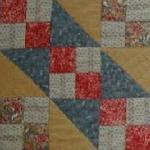America's Quilting History
The Underground Railroad and Abolition Quilts
 A war never really starts with the first shot. There are years of events leading up to it as well as years of recovery after. So when we think of Civil War quilts we are really talking about many years of quilting.
A war never really starts with the first shot. There are years of events leading up to it as well as years of recovery after. So when we think of Civil War quilts we are really talking about many years of quilting.
The story of Civil War quilts is a mixture of fact and myth. The oral tradition may not give us absolutely accurate information but it often reflects a greater truth of our pride in our country and hopes for it's future. There are intriguing stories of how quilts were used to help the slaves escape through the Underground Railroad. A Log Cabin quilt hanging in a window with a black center for the chimney hole was said to indicate a safe house. Underground Railroad quilts, a variation of Jacob's Ladder, were said to give cues as to the safe path to freedom. Research on the Underground Railroad has found no evidence that this actually occurred but these stories have been told from generation to generation filling our imagination with visions of quilts being a part of the flight for freedom. While we enjoy these stories it is important to be aware that quilts may never have been used in this way.
 In her article on the Underground Railroad quilt block Barbara Brackman tells us, "As a quiltmaker I’ve always loved the pattern and the secrets hidden in the name. But as historian I’ve come to realize that there are no known quilts in this pattern dating back to the days of the Civil War or to the decades before the War when the Underground Railroad flourished".
In her article on the Underground Railroad quilt block Barbara Brackman tells us, "As a quiltmaker I’ve always loved the pattern and the secrets hidden in the name. But as historian I’ve come to realize that there are no known quilts in this pattern dating back to the days of the Civil War or to the decades before the War when the Underground Railroad flourished".
Another area where the line between truth and myth is blurred is on specific quilt blocks with names like Lincoln's Platform, Sherman's March, Birds in the Air and Evening Star. The first documented Log Cabin quilt is not dated until sometime during the Civil War and the pattern wasn't really common until after the war. The Log Cabin may have become popular after the death of Abraham Lincoln. His leadership in freeing the slaves might explain the stories that Log Cabin quilts were a part of the flight to freedom. Perhaps many of these favorite blocks were really made and named in memory of the Civil War and the freeing of the slaves.
What we are certain of is that in the north women made quilts with inscriptions on them indicating the evils of slavery. Some even included a sketch of a slave in shackles. The following antislavery poem is published in the book, "Quilts From the Civil War".
"...I'd sooner spend my days within
Some dark and dismal cave
Than to be gulilty of the sin
Of holding one poor slave." 1
 As early as the 1830s abolitionists were actively pushing for antislavery laws. They hosted many handicraft fairs over the years to raise money for their cause and to keep it in the public eye. Women made various items including clothing, decorative items, afghans and quilts for these fairs. "The first Anti-Slavery Fair was held in Boston in 1834, and it was so successful the idea spread to other cities and towns throughout New England, and then to other states such as Ohio and Pennsylvania." 2
As early as the 1830s abolitionists were actively pushing for antislavery laws. They hosted many handicraft fairs over the years to raise money for their cause and to keep it in the public eye. Women made various items including clothing, decorative items, afghans and quilts for these fairs. "The first Anti-Slavery Fair was held in Boston in 1834, and it was so successful the idea spread to other cities and towns throughout New England, and then to other states such as Ohio and Pennsylvania." 2
Female Anti-Slavery Societies were formed by free black women and white women. These organizations circulated petitions, provided schools for black children and raised needed money. In 1834 the abolitionist journal, "The Liberator" reported on an Anti-Slavery Fair. The article mentions, "We are told the colored ladies of Salem particularly deserve thanks for the interest they took in the Fair, and the articles they sent." 3
These abolitionist activities had a powerful influence on events leading up to the war.
© 2001 Anne Johnson (Do not reproduce any material from this site without permission.)References:
1 p 9"Quilts from the Civil War", by Barbara Brackman
2 p 72, "Hearts and Hands: The Influence of Women & Quilts on American Society", by Pat Ferrero, Elaine Hedges and Julie Silber.
3 p 31, "Always There: The African American Presence in American Quilts", by Cuesta Benberry.
"Quiltmaking in America: Beyond the Myths", Laurel Horton (Editor)
Web Page: "The Underground Railroad and the Use of Quilts as Messengers for Fleeing Slaves", by Kimberly Wulfert, PhD
Web Page: Quilts and the Underground Railroad, by Barbara Brackman


